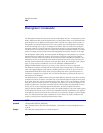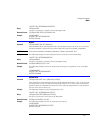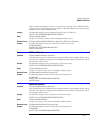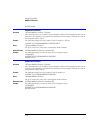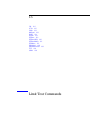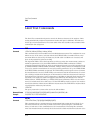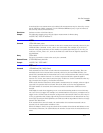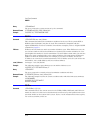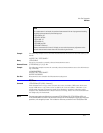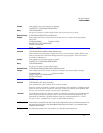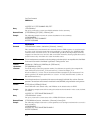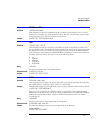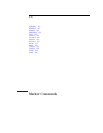
15-4
Limit Test Commands
RUNTil
Query :LTESt:MNFound?
The query returns the current action set by the command.
Returned Format [:LTESt:MNFound] {FAIL | PASS | IGNore}<NL>
Example 10 OUTPUT 707;”:LTEST:MNFOUND PASS”
RUNTil
Command :LTESt:RUNTil FAILures, <total_failures>
This command determines the termination conditions for the test. The keywords RUN or
RUMode (Run Until Mode) may also be used. This command is compatible with the
Agilent 83480/54750. To run for a number of waveforms or samples, refer to ACQuire:RUNTil
command on page 6-4.
FAILures FAILures runs the limit test until a set number of failures occur. When FAILures is sent, the
test executes until the selected total failures are obtained. The number of failures are com-
pared against this number to test for termination. Use the FAILures mode when you want the
limit test to reach completion after a set number of failures. The total number of failures is
additive for all of the measurements. For example, if you select 10 failures, the total of
10 failures can come from several measurements. The 10 failures can be the sum of four rise
time failures, four +width failures, and two overshoot failures.
<total_failures> An integer: 1 to 1,000,000,000.
Example The following example causes limit test to run until two failures occur.
10 OUTPUT 707;”:LTEST:RUNTil FAILures, 2”
Query :LTESt:RUNTil?
The query returns the currently selected termination condition and value.
Returned Format [:LTESt:RUNTil] {FAILures, <total_failures>}<NL>
Example The following example returns the current condition under which the limit test terminates.
10 DIM RUN$[50]
20 OUTPUT 707;”:LTEST:RUNTIL?”
30 ENTER 707;RUN$
SOURce
Command :LTESt:SOURce {1 | 2 | 3 | 4}
This command selects the current source for the ULIMit, LLIMit, MNFound, and FAIL com-
mands. It selects one of the active measurements as referred to by their position in the mea-
surement window on the bottom of the screen. Source 1 is the measurement on the top line,
2 is on the second line, and so on.



